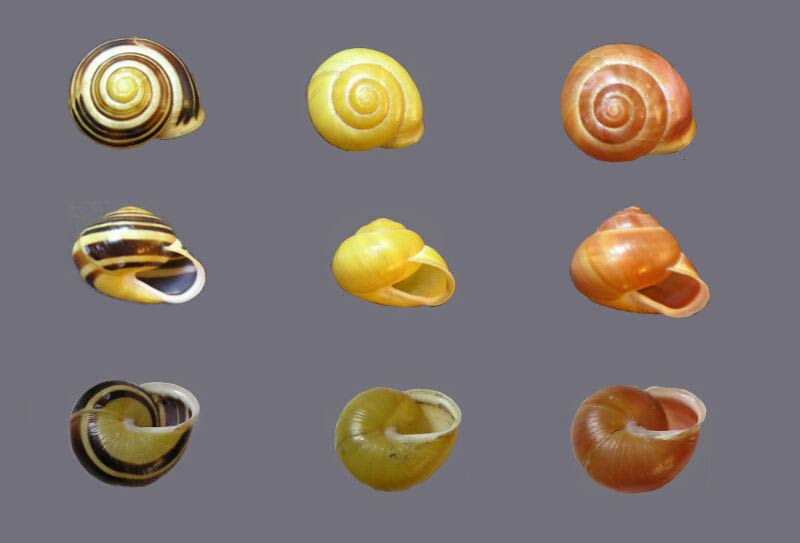Cepaea hortensis
|
Cepaea hortensis. (Photo: © J. Novak, www.biolib.cz) |
|
Cepaea hortensis. (Photo: © J.K. Lindsey, The Ecology of Commanster) |
|
Cepaea hortensis. (Photo: © J.K. Lindsey, The Ecology of Commanster) |
|
Cepaea hortensis. (Photo: © J.K. Lindsey, The Ecology of Commanster) |
|
Cepaea hortensis. (Photo: © Dr. Roy Anderson, MolluscIreland) |
|
Cepaea hortensis: genitalia. (Photo: © J. White, U.F.) |
Family
Helicidae
Species
Cepaea hortensis (Muller, 1774)
Common name
White-lipped snail, Small banded snail
Description
The glossy shellShell:
A hard, inflexible, calcareous or chitinous structure that vary in size and may either completely encasing the animal, covering some part of it or be internal.
of this snail ranges in heightHeight:
The height of the shell is a measure of the distance between the apex and the most basal part of the shell OR the measurement taken from the apex of the shell to the base, when measured parallel to the axis of the shell.
from 10 to 18 mm and a diameter of 14 to 22 mm. The number of whorlsWhorls:
Pleural of whorl. A whorl is a complete spiral turn/growth of the shell of a mollusc. The whorls are counted from the apex outwards.
on the shellShell:
A hard, inflexible, calcareous or chitinous structure that vary in size and may either completely encasing the animal, covering some part of it or be internal.
may be either 5 - 5 1/2 depending on locality. The shellShell:
A hard, inflexible, calcareous or chitinous structure that vary in size and may either completely encasing the animal, covering some part of it or be internal.
is smooth and may have a uniform color that ranges from primrose yellow, olive-yellow, grey-yellow or grey-yellow brown with the lipLip:
The margin of the aperture, which may be sharp or thickened depending upon the species (Also see apertural lip).
being white in color. The shells may have one or five stripes that are chestnut-brown in color. There are also fine growth lines on the external surface of the shellShell:
A hard, inflexible, calcareous or chitinous structure that vary in size and may either completely encasing the animal, covering some part of it or be internal.
.
Cepaea nemoralis and C. hortensis can be separated by the their distinctly colored apertural lipApertural lip:
The margin of the aperture, which may be sharp or thickened depending upon the species (Also see lip).
. In adult specimens of C. nemoralis the lipLip:
The margin of the aperture, which may be sharp or thickened depending upon the species (Also see apertural lip).
is always brown, while that of C. hortensis is white. Also C. nemoralis is larger than C. hortensis.
Native range
Western and Central Europe
Distribution
North America:
- U.S.: Massachusetts, New York, Vermont
- Canada: Newfoundland, Quebec
Atlantic Islands: Iceland
Europe: Central and Northern
Ecology
This snail typically infests greenhouses and its longevity is approximately 5 years.
Synonyms
- Helix subglobosa A. Binney, 1837, Boston Journ. Nat. Hist., 1:485
- Helix hortensis Muller, 1774. Verm. Hist., 2: 52; A. Binney, 1851, Terr. Moll., 2:111, l8 Tachea hortensis W. G. Binney, 1878, Terr. Moll., 5: 378, figs. 262, 263
References
Anderson 2005Anderson 2005:
Anderson, R. 2005. An annotated list of the non-marine Mollusca of Britain and Ireland. Journal of Conchology 38: 607-637.; Boycott 1934; Horsák et al. 2004Horsák et al. 2004:
Horsák, M., L. Dvorák and L. Juricková. 2004. Greenhouse gastropods of the Czech Republic: current stage of research. Malacological Newsletter 22: 141-147.; Kantor et al. 2009Kantor et al. 2009:
Kantor, Y.I., M.V. Vinarski, A.A. Schileyko and A.V. Sysoev. 2009. Catalogue of the continental mollusks of Russia and adjacent territories. Version 2.1. (Accessed online July 20, 2010); Kerney et al. 1979Kerney et al. 1979:
Kerney, M.P., R.A.D. Cameron and G. Riley. 1979. A field guide to the land snails of Britain and North-west Europe. Collins, London. pp. 288.; Pilsbry 1939Pilsbry 1939:
Pilsbry, H. A. 1939. Land Mollusca of North America north of Mexico vol. I part 1. Academy of Natural Sciences, Philadelphia. pp. 1-574.







